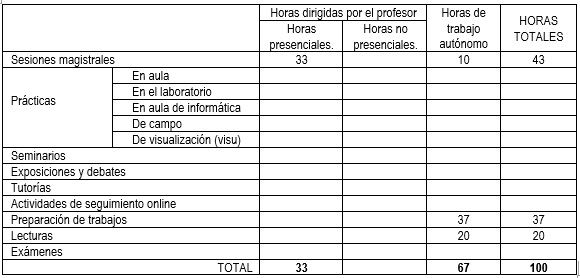TERRORISM, INSURGENCY AND POLITICAL VIOLENCE
GRADO EN ESTUDIOS GLOBALES/GLOBAL STUDIES
Curso 2023/2024
1. Subject Information
(Date last modified: 29-05-23 12:52)- Code
- 109035
- Plan
- 290
- ECTS
- 4.00
- Type
- Opcional
- Year
- 3
- Duration
- Second semester
- Area
- CIENCIA POLÍTICA Y DE LA ADMINISTRACIÓN
- Departament
- Derecho Público General
- Virtual platform
Professor Information
- Profesor/Profesora
- Elena María Gil Moreno
- Group/s
- Único
- Centre
- Fac. Derecho
- Office
- Espacio ACPA, Planta Jardín
- Office hours
- Under request by email
- Web address
- https://acpa-usal.com/member/dra-elena-gil-moreno/
- elenagm@usal.es
- Telephone
- 923 29 44 00 - Ext. 1617
2. Association of the subject matter within the study plan
Curricular area to which the subject matter pertains.
Political Science
Purpose of the subject within the curricular area and study plan.
Elective, political behavior
Professional profile.
Political Science
3. Prerequisites
None
4. Learning objectives
Throughout this course students will reflect on the nature of political violence, its causes, and consequences. They will also gain a broad view of the interconnection of conflicts around the world and their relationship to imperialist policies.
At the end of this course students will be able to:
- Differentiate the diverse types of political violence that have emerged in different regions of the world.
- Understand the complexity of the phenomena of political violence and the politics of counterterrorism and counterinsurgency.
- Identify the challenges of new and old forms of political violence that we are facing today.
5. Contents
Theory.
Introduction: Political Violence, Theoretical Approaches
Terrorism 1: International and Domestic Terrorism, Stages of Terrorism and Discussion about the Concept of Terrorism
Terrorism 2: Radicalization and Recruitment to Terrorist Groups, Terrorism Databases and Cyberterrorism
Insurgencies: Actor Types, Strategies and Tactics, the Cold War
State Violence: Counterinsurgency and Counterterrorism strategies, Actor Types, and the Political Terror Scale
Criminal Governance: The Mafia and Narco-governments
Practice.
Case studies
6. Competences acquired
Basic / General.
CB2, CB3, CB4 CG1, CG2, CG4
Specific.
CE2, CE15, CE20
7. Teaching methods
Lecture, Seminars, Debates, practical assignments
8. Anticipated distribution of the use of the different teaching methods

9. Resources
Reference books.
Ahmad, A. (2017). Jihad & Co.: black markets and Islamist power. Oxford University Press.
Akilu, F. (2021). Peaceful Societies and Leaving No One Behind. In Fulfilling the Sustainable Development Goals (pp. 407-416). Routledge.
Alonso, R. et al. (2008). Radicalization Processes Leading to Acts of Terrorism, European Commission
Apter, D. (1997). The legitimization of violence. NYU Press.
Asri, F. E., & Mesa, B. (2021). Extrémisme (s) violent (s) en perspective: jeunes et femmes dans le contexte marocain. Extrémisme (s) violent (s) en perspective: jeunes et femmes dans le contexte marocain, 139-158.
Body-Gendrot, S., & Spierenburg, P. (Eds.). (2008). Violence in Europe. Springer-Verlag New York.
Body-Gendrot, S., & Spierenburg, P. (Eds.). (2008). Violence in Europe. Springer-Verlag New York.
Brown, M. E., Cote Jr, O. R., Lynn-Jones, S. M., & Miller, S. E. (Eds.). (2010). Contending with Terrorism: Roots, strategies, and responses. MIT Press.
Calle, L., & Sánchez-Cuenca, I. (2011). What we talk about when we talk about terrorism. Politics & Society, 39(3), 451-472.
Cockburn, P. (2016). Chaos & Caliphate: Jihadis and the West in the Struggle for the Middle East, Or Books Llc
Grajales, J. (2013). State Involvement, Land Grabbing and Counter-Insurgency in Colombia (Development and Change), 44(2) pp 211-232
Hoffman, B. (2018). Inside terrorism. In Inside Terrorism. Columbia University Press.
Hoffman, B., & Reinares, F. (Eds.). (2014). The evolution of the global terrorist threat: From 9/11 to Osama bin Laden's death. Columbia University Press.
Johnston, J. (2000). Pedagogical guerrillas, armed democrats, and revolutionary counterpublics: Examining paradox in the Zapatista unprising in Chiapas Mexico. Theory and Society, 29(4), 463-505
Koppel, T. (2015). Lights out: a cyberattack, a nation unprepared, surviving the aftermath. Broadway Books.
Lessing, B. (2021). Conceptualizing criminal governance. Perspectives on Politics, 19(3), 854-873
López, T. M. (2018). Terrorismo y comportamiento político: España y el caso de ETA, Doctoral dissertation, Universidad Autónoma de Madrid.
Mbembe, A. (2008). Necropolitics. Palgrave Macmillan UK.
McMahon, Robert J. (2003). The Cold War: A Very Short Introduction, Oxford University Press
Mesa, B. (2017). Le rôle transformateur des groupes armés du nord du Mali: de l'insurrection djihadiste et sécessionniste au crime organisé (1996-2017) (Doctoral dissertation, Université Grenoble Alpes (ComUE)).
Mueller, J. (2008). The Atomic Terrorist: Assessing the Likelihood. prepared for presentation at the Program on International Security Policy, University of Chicago, 15.
National Consortium for the Study of Terrorism and Responses to Terrorism (2020). Global Terrorism Index 2020, Institute for Economics and Peace
Richards, A. (2014). Conceptualizing terrorism. Studies in Conflict & Terrorism, 37(3), 213-236.
Sánchez-Cuenca, I., & De la Calle, L. (2009). Domestic terrorism: The hidden side of political violence. Annual Review of Political Science, 12, 31-49.
Shapiro, J. N. (2013). The terrorist's dilemma. In The Terrorist's Dilemma. Princeton University Press.
Tilly, C. (2003) The Politics of Collective Violence. New York: Cambridge University Press
Trejo, G., & Ley, S. (2018). Why did drug cartels go to war in Mexico? Subnational party alternation, the breakdown of criminal protection, and the onset of large-scale violence. Comparative Political Studies, 51(7), 900-937.
United Nations Office on Drugs and Crime (2012). The Use of the Internet for Terrorist Purposes, United Nations
US Government (2012). Guide to the Analysis of Insurgency, US Government
White, J. R., & Clear, T. (2002). Terrorism: an introduction. Stanford, CA: Wadsworth Thomson Learning.
10. Assessment
Assessment tools.
- Assignments 40%
- Theoretical assesment tasks 60%
Guidelines in the case of failing the subject.
Evaluation tools will be the same.


